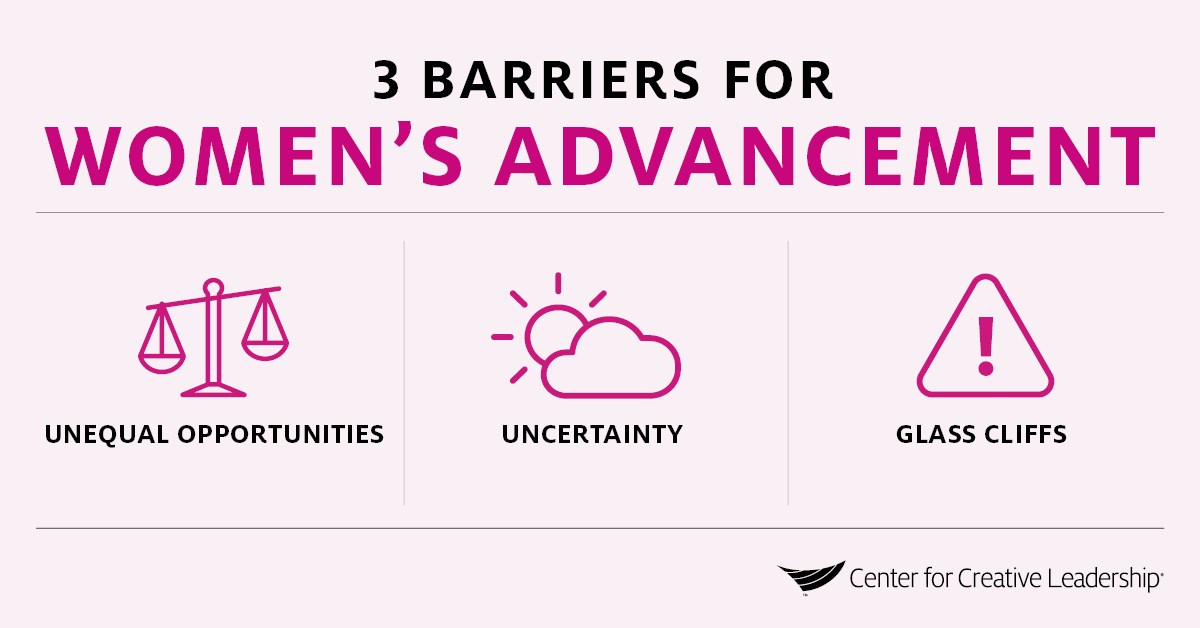Overcoming Obstacles to Women’s Advancement in the Workplace
Women are now leaving the workforce at much higher rates than men, and the global COVID pandemic has disproportionately affected women professionals. The gains made by women in the workforce over the past 3 decades have been undone in just the past couple of years, with women’s labor force participation dropping to its lowest level since 1987, sources say.
Yet even before the pandemic, there were significant barriers to women’s advancement, and fewer women in leadership roles.
That’s why it’s critical that organizations make intentional efforts to invest in overcoming obstacles to female leadership.
Before the onset of the pandemic, we conducted a research study of over 300 men and women leaders to understand the realities about women in the workplace. In short, having more women in the workplace actually makes an organization a better place to work, for people of all genders.
At CCL, we’ve been exploring how organizations can bolster female leadership and unlock the benefits of gender parity in the workplace.
What Barriers Do Women Leaders Face?
The Push & Pull Factors
When it comes to taking on leadership roles and seeking advancement, men and women have many of the same concerns, including pay, work-life “balance” issues, and pressures to relocate. But women also have some concerns that most men don’t.
For example, women face “push” and “pull” factors that serve as roadblocks. The pull factors are internal limitations that women place on themselves that pull them away from leadership roles, whereas the push factors are external limitations from others in their organization or society that push them away from leading. Of course, push and pull factors are intertwined, as are the ways that women respond to them.
3 Barriers to Women’s Advancement
For organizations that want to grow their ranks of women leaders, these unique obstacles to female leadership must be acknowledged and addressed.
Barrier #1: Not being offered equal opportunities.
In our study, women told us that they often didn’t receive the same advancement and leadership opportunities as male peers. They felt they had to work harder to be afforded the same opportunities as men, and often had to overcome assumptions about their capabilities and actions due to their gender.
In some cases, women reported that experienced female executives were brought into organizations at a lower level than male counterparts, meaning they had to invest more time to get to the same level as male peers.
These are examples of the externally driven push factors that serve as obstacles to women’s leadership.
Our findings were consistent with other researchers. For example, studies find organizations expect women to be more qualified than men for the same positions, others show women are hired based on experience instead of “potential,” and still more have shown that leadership opportunities for men often come with more resources.
The common thread is “the double-bind” that women face of being seen as either competent or likable — but not both.
Barrier #2: Lack of confidence.
Women in our study were also more likely to report that they felt unsure of themselves. Sometimes that meant they wondered if they were really qualified for a leadership position, had trouble seeing themselves as leaders, or struggled to overcome impostor syndrome and self-limiting thoughts.
In other cases, they wondered if others really wanted them in a leadership role, and therefore if they would receive support. They reported challenges with asking for money (such as in a sales role, or when negotiating for salary), as well as overcoming perfectionism. These are examples of internally driven pull factors that serve as a barrier to women’s leadership.
And according to another research study we conducted, another obstacle facing women leaders is the high level of tenacity required for the long and challenging leadership journey they face.
Barrier #3: Glass cliffs.
Finally, women reported being offered leadership “opportunities” in no-win roles. Sometimes the leadership roles or challenges came without sufficient resources or were structured in a way that made failure more likely. This is reflected in a separate study that found that FTSE 100 Index companies were more likely to appoint women to their boards following an extended period of poor stock market performance.
These precarious, high-risk leadership roles create problems for women, as a high-profile failure in a leadership role can derail their careers. Because of this, social scientists refer to these opportunities as “glass cliffs” — since women who break through the glass ceiling might find themselves quickly falling back down. This, too, represents an external, societal push factor that serves as a barrier to women’s leadership.
Overcoming Obstacles to Female Leadership and Strengthening the Pipeline of Women Leaders
2 Key Steps for Organizations & Leaders
Addressing these barriers to women’s leadership requires a twofold approach.
1. Cultural and organizational obstacles must be addressed first.
It’s more important than ever to take a focused, systematic approach to retaining and developing women leaders.
Take concrete, intentional steps to evolve your organizational practices, procedures, and culture to orient toward building greater parity and developing all leaders. Above all, organizations should create the culture and systems that make it easier for employees to bring their whole selves to work.
2. Women should get the same kinds of leadership training and opportunities as men.
Your women leaders will certainly benefit from leadership development training opportunities. You may want to provide this in a mixed-gender context or specific women-only leadership development training that addresses some of the specific challenges they face.
At CCL, one area where we have recently pursued this is in the technology industry, which has a dismal track record of retaining women as they advance in their careers. A 2016 study from the National Center for Women & Information Technology found that after 19 years, fewer than half of women in professional STEM (science, technology, engineering, and math) jobs were still in the field. By comparison, more than 90% of women in non-STEM professional jobs stayed in their field over the same period.
To address this and help support more women in the tech industry, we partnered with more than 2 dozen mid-level, female engineers and technologists to help them overcome some of the barriers they face in their careers. This pilot program provided relevant insights for leadership initiatives designed to grow the pipeline of women in any industry:
- Credibility matters. Women want credible, research-backed approaches to leadership development. Women want to understand where an idea or approach comes from and why they should take it seriously.
- It’s a process. Learning new tools and techniques and then applying them takes time. Women need an opportunity to not only gain new skills, but also to apply them on the job.
- Challenging assignments are needed. To develop their leadership skills, women need access to challenging assignments and on-the-job learning where they can develop through experiences in a way that produces valuable results for themselves and their organizations.
- Relationships rule. Women leaders can be more successful when they have opportunities to establish relationships and build networks, especially with each other. Such networks give women a place to seek out informal advice and access career opportunities.
- Mentoring is a powerful tool. Aspiring women leaders can benefit greatly from female mentors who are farther along the leadership path. Women supporting other women can help, but women need a network of champions of all genders to help them navigate the challenges they’ll face.
Strengthening the leadership pipeline for women and overcoming barriers to women’s advancement is imperative for any organization that wants to benefit from more diverse perspectives and the more supportive management style women bring to the workplace.
Yet most, if not all, organizations will need to make strategic, deliberate choices to grow their ranks of women leaders and help them overcome the barriers they face in the workplace.
Ready to Take the Next Step?
We can help your organization overcome obstacles to women’s leadership with our customized women’s leadership development training, or partner with us to create an organizational culture where all your talent can thrive.












